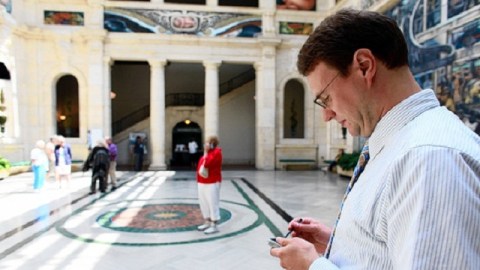Every Move You Make: Stalking Patrons at the Museum

I always used to laugh at people who ignored the lyrics to “Every Breath You Take” by The Police and thought it was a lovely love song. If it’s about love at all, it’s about obsessive love—creepy, obsessive love that watches you through the windows late at night as you sleep. Stalking, however meant, always seems wrong. That song popped into my head when I read Isaac Arnsdorf’s piece in the Wall Street Journal titled “The Museum Is Watching You: Galleries Quietly Study What People Like, or Skip, to Decide What Hangs Where.” In the never-ending effort to make museums more successful in reaching the public (and reaching the public’s wallet), museums are now taking marketing to the next level by literally standing behind viewers and recording their every move. Like the lover in the song’s lyrics, museums now watch “every move you make” in hopes of cracking the code of what you want to see and how you want to see. But is building the better museum this way really best for the art world and the public?
Arnsdorf profiles Matt Sikora, “evaluation director” of the Detroit Institute of Arts, in his quest to crawl inside the mind of the museum-goer. Like a hunter lining up deer, Sikora silently sidles behind or beside patrons and records on a hand-held device (shown above) data such as who the patrons are demographically (gender, age, etc.), how long they spent in a particular room, whether they read the wall plaques, and which paintings they looked at (or didn’t). The Detroit Institute of Arts wants to evaluate some of their redesigned galleries to see how the public receives them. Unfortunately, collecting data via surveillance is so slow going that Sikora expects his research will not be finished until 2012.
Although Arnsdorf’s piece traces museum research of this type to the 1920s and how prevalent this trend is across the U.S., it only briefly addresses the concerns of people who question a quantitative approach to the qualitative world of the arts. In other words, can you really put an aesthetic experience into numerical terms? Aside from this philosophical debate, I’m not sure that the data collection is really objective. Are Sikora and others accounting for the “observer effect,” in which the presence of the researcher affects the subjects studied? Is it possible that having someone nearby in plain view entering information into a machine could drive people to react one way or another? I can imagine some people feeling violated and moving on more quickly than they would like. Or, in the opposite direction, people might feel a need to act more “cultured” and stare down a wall plaque mumbling, “hmmmm… Seurat…”
Is time spent reading wall plaques really a barometer of installation effectiveness? Certainly some people gloss over unfamiliar names and stop in their tracks for familiar names. Does that mean that a Van Gogh is always more effective than a lesser-known artist? Would the results of this study unfortunately crowd out amazing works by lesser-known artists simply due to lack of name recognition. When Albert Barnes developed his Barnes Foundation, he eschewed wall plaques entirely in an attempt to create a “pure” experience freed of the elitist filtering that such peripherals can generate. I feel that there’s a place for wall text, but I don’t see it as the deal breaker of an effective or ineffective installation.
What bothered me the most from Arnsdorf’s piece was how the information was being used to modify wall text. Believing that people skip the plaques because they’re too long or too difficult to read, museums are cutting down the length of the text and even putting them in bullet points. Anyone who’s suffered through the PowerPoint-ification of business communication today knows how dumbed down bullet points can make any concept. Do we really want art dumbed down to some lowest common denominator? Aren’t museums and art entrusted with a mission to challenge the public and make us work to embrace the experience? It’s fine to expect the museum to come halfway to the public, but this data quest seems like museums going too far in their outreach. I hope, and trust, that some thought will be brought to the analysis of the data. Art by numbers alone isn’t art. Not every move by a museum patron speaks volumes, but the next move by museums using this technique will.





